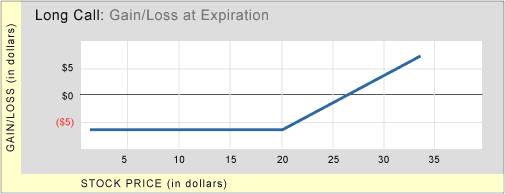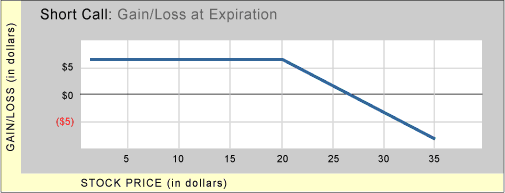
Straight Calls refers to the purchasing or selling of call options to open a position. This strategy is also commonly referred to as Long or Short Calls. Generally, these two strategies are speculative in nature.
A strategy consisting of the purchase of a Call option. This strategy is generally used to speculate on the upward move of the underlying security or index.
For use when investor anticipates:
Financial Characteristics:
Objective:
* The maximum loss on a straight Call is limited as long as, and only as long as, the investor does not exercise the long call. There is an additional risk associated with the expiration weekend. If the long call is exercised, the investor ends up with a long position in the stock. Bad news during the weekend could force even greater losses on the investor before he can exit the long equity position.
EXAMPLE (Long Straight Call)
Currently, XYZ trades at $25/share. The investor employs the strategy of buying one in-the-money call (strike $20) for $6.00/share (1 contract= $600). Using this strategy, the investor pays a cash debit of $6.00. This is the maximum loss the investor can incur. If the stock decreases to $19.00/share the long call will expire worthless and the investor loses the $6 premium. The maximum gain if the stock price is higher than the strike is the difference between the closing price and the call strike, less the call premium spent. If the stock is trading at $30, then 30-20-6 = $4 profit. The break even point for the strategy occurs when the price of XYZ is at $26.

The Short Straight Call may allow an investor to profit from downward movements in the underlying security or index. It uses the exact opposite structure as the Long Call. If the security or index falls in value, the investor can generally profit. The maximum profit is the premium received by selling the option. If the security rises in value, the maximum loss is unlimited.
For use when investor anticipates:
Financial Characteristics:
Objective:
EXAMPLE (Short Straight Call)
Currently, XYZ trades at $25/share. The investor believes the stock will fall and wants to benefit from the downward movement. The investor shorts a Straight Call option (strike $20) for $6.00/share (1 contract= $600). The maximum loss is unlimited should the stock prices suddenly rise in price. The maximum loss would be calculated by taking the closing price at expiration less the strike price, less the credit received on the sale of the option. If the stock closes at $32 on expiration, there will be a $6 loss ($32-$20-$6=$6 loss). The maximum profit an investor can receive is the credit received when selling the option. For example, if the same XYZ 20 strike option is sold for $6, and the stock closes under $20, the option expires worthless, and the investor can pocket the entire $6. The break even point for the strategy occurs when the price of XYZ is at $26.

Commissions, taxes, and transaction costs are not included in any of these strategy discussions, but can affect final outcome and should be considered. Please contact a tax advisor to discuss the tax implications of these strategies. Many of the strategies described herein require the use of a margin account. With long options, investors may lose 100% of funds invested. In-the-money long puts need to be closed out prior to expiration, since exercising them could create short stock positions.
Options carry a high level of risk and are not suitable for all investors. Certain requirements must be met to trade options through Schwab. Multiple leg options strategies will involve multiple commissions. Please read the options disclosure document titled "Characteristics and Risks of Standardized Options." Member SIPC
Copyright ©Charles Schwab, & Co., Inc. 2010. All rights reserved. Member SIPC. (1010-6351)